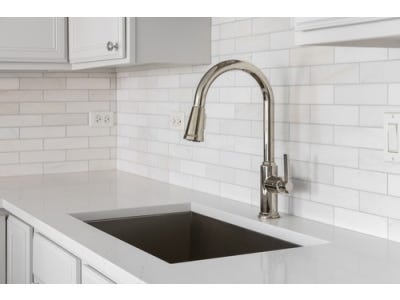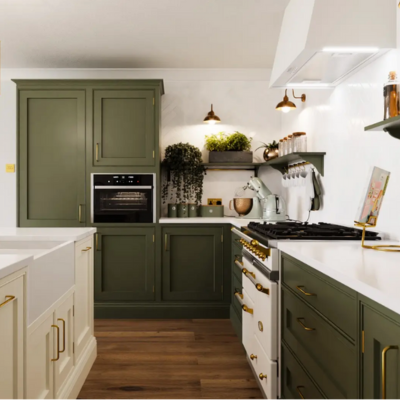Choosing the right kitchen sink may seem like a straightforward decision, but with so many styles, materials, and features available today, it can be a bit overwhelming.
The right sink can enhance the aesthetic of your kitchen and make your daily tasks more efficient.
Whether you're remodelling your entire kitchen or simply updating your sink, several factors to consider include size and material, mounting options, and budget.
We’ve put together a comprehensive guide on how to choose the right kitchen sink for your home.
Assess your kitchen’s layout and size
When choosing a kitchen sink, one of the most important factors to consider is how it will fit within your kitchen’s layout and size.
Getting the right size is vital to ensure that everything in your kitchen works harmoniously together.
The size of your sink should be proportional to the amount of worktop space you have. If the sink is too big, it’ll overwhelm a small kitchen, while a sink that’s too small will be impractical and look out of place in a big kitchen.
So, how do you determine the ideal size?
- Measure counter space: Measure the area where the sink will be installed. Standard sinks will range between 24 and 36 inches in width. For those with a smaller kitchen, a compact sink of 18–22 inches will help to maximise your countertop space. However, a larger kitchen can look best with a sink that’s 33 inches wide.
- Consider your work triangle: The kitchen ‘work triangle’ is the space between the sink, hob, and refrigerator, the three busiest areas of the kitchen. Install a sink that sits well in this space; one that’s too large might crowd the area and disrupt the flow, particularly in small kitchens.
- The impact on counter space: The larger the sink, the less counter space you’ll have. If you need ample prep space for cooking, choose a sink that will accommodate this.


Sink Materials: What’s Best for You?
Stainless Steel Sinks
Stainless steel sinks have long been the go-to choice for kitchen renovations, mostly due to their durability. Here are some other reasons why you might consider a stainless steel sink:
- Durable
- Highly resistant to cracking and chipping
- Won’t be damaged by high temperatures
- Easily cleaned
- Resistant to rust and corrosion
- Budget-friendly
Composite Granite Sinks
Composite granite sinks combine strength and style. Made from natural granite stone combined with resin, they have a tough and durable surface designed to look and feel like real stone.
- Strong and durable
- Resistant to scratches and chips
- Available in a range of colours
- Luxury stone finish
- Resistant to heat
- Stain resistant


Ceramic Sinks
Ceramic sinks have a long history in kitchen design thanks to their classic appeal. With traditional charm, they offer a timeless quality.
- Resilient
- Highly resistant to scratches, stains and heat
- Easy to clean
- Don’t discolour
- Durable and timeless
Cast Iron Sinks
Cast iron sinks may be on the higher end of the budget, but their durability and traditional elegance more than makeup for that. They are made from a solid cast iron base coated in an enamel layer to give them a glossy and durable finish.
- Tough surface
- Solid and weighty presence
- Durable
- Resistant to heat, scratches and stains
- Smooth, non-porous surface


How to choose the right kitchen sink formation
Another element to consider when choosing the right kitchen sink is its shape.
There are single sinks, one-and-a-half sinks, double sinks, and even prep sinks to choose from. Each has its advantages and suits different lifestyles and kitchen sizes.
Single bowl sinks
Single-bowl sinks are best for smaller kitchens where countertop space needs to be optimised.
They’re ideal for washing large pans and baking trays, and their simple design makes them easier to clean. The obvious downside is that you can only use the sink for one thing at a time.
One-and-a-half bowl sinks
A 1.5 kitchen sink consists of a bigger bowl and a smaller bowl. These can be great for homes where multiple people might be working in the kitchen.
You can use the bigger bowl for washing dishes, and then you still have the accessibility to rinse food, make drinks, etc. in the smaller sink.


Double sinks
Double sinks are designed with two bowls of the same size. This is great for rinsing and washing dishes simultaneously.
However, it takes up a lot of worktop space, so it’s not an ideal sink formation for small kitchen spaces.
Prep sinks
Prep sinks are typically installed as secondary sinks in large kitchen areas.
This is great for those with really large kitchens, but these designs don’t typically fit in pots and pans, so you can’t wash your dishes easily from them.
Types of Mounting Options
The way a sink is mounted will impact the overall look of the kitchen. It can also affect how easily the sink is installed and how much worktop space is used.
These are the most common types of mounting options to consider when deciding how to choose the right kitchen sink.
- Undermount sinks: Installed underneath the worktop, under-mount sinks give your kitchen a clean and seamless finish. There’s no visible rim, allowing your worktop material to flow smoothly right up to the edge of the sink. These sinks are more expensive to install as they require strong brackets and adhesives to ensure the sink's weight is properly supported.
- Top-mount sinks: Also known as drop-in sinks, they are installed by cutting a hole in the worktop, and the sink is simply ‘dropped in.’ The sink’s rim will sit atop the counter. Thanks to the simplicity of installation, this can be a DIY job. This installation suits laminate, wood, and solid-surface countertops.
- Integrated sinks: Sleek and streamlined, integrated sinks blend the sink directly into the countertop material. The sink and worktop are made from the same material, which can be quartz, solid surfaces, or stainless steel. With no joins, lips, or edges, they’re incredibly easy to clean and enhance the streamlined appearance of the kitchen.


How to choose the right kitchen sink - Lifestyle and usage
Another factor to consider when deciding on how to choose the right kitchen sink, is the usage of your kitchen.
You want a sink that matches your kitchen’s aesthetic but also accommodates your needs and lifestyle. It’s important to factor in your cooking habits and cleaning routines.
Cooking frequency
If you cook daily and prepare large meals for family and friends, you need a sink that can handle a variety of tasks and a large amount of dishes.
A small, single-bowl sink might be enough for those who only use the kitchen for light cooking or preparing quick and easy meals.
Cleaning preferences
Cleaning and maintaining your sink should be another factor in your kitchen sink decision. Different materials require varying levels of care.
Stainless steel and composite granite are great choices for those who don’t require much maintenance. However, materials like ceramic and cast iron might be more prone to scratches, chips, and stains if they’re not cared for properly.
Dishwashing habits
If you have a dishwasher, you’ll only be using your sink to rinse plates and wash the odd bits of crockery; therefore, a small sink should be sufficient.
However, if you’re washing dishes by hand, a large sink or even a double bowl might be suitable for soaking and rinsing easily.
Choosing a kitchen sink isn’t just about picking something that looks good; it’s about finding a sink that suits your aesthetics, lifestyle and space. The right sink can make your time in the kitchen a little more efficient, and thanks to the myriad of design options available, you can find one that suits your decor perfectly.








